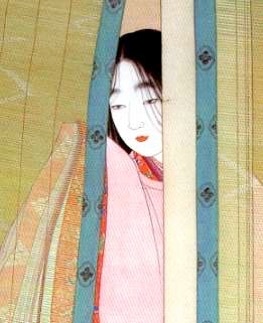Katako
Murasaki's only child, her daughter Katako (999-1083) managed to achieve every mark of success in her court career. Indeed her experience was so different from her mother's as to make one think that Murasaki must have gone to great pains to coach her. It is not hard to imagine a mother trying her best to see that her daughter would not suffer the kind of depression and alienation she herself did.
Katako was attractive, pursued by a number of high-ranking men, including Fujiwara Kanetaka, a nephew of Michinaga. She had a daughter by Kanetaka when she was 27, at that time becoming wetnurse to the future Emperor Go-Reizei. About this daughter nothing at all is known.
I have taken the liberty of imagining Katako's daughter as something of a literary black hole—someone incapable of, or at least unwilling to, accept her formidable literary heritage. At the beginning of my tale, Katako finds Murasaki's last journal after her mother's death and saves it to pass on to this unnamed daughter. Her presumption is that the daughter will preserve it and make it public, along with the final chapter of The Tale of Genji, at some future date. Of course, this does not happen.
Katako married Takashina no Nariakira in 1038, and bore a son. In 1045 she was raised to the prestigious rank level "Junior, third class"—about as high as a person of non-imperial blood could rise—and was given the position of Principle Handmaid.
Thirty-seven of Katako's poems are anthologized in imperial collections. Along with her mother Murasaki, she is counted as one of the "Thirty-six Immortal Women Poets" (Onna Sanjūrokkasen) of the classical era. In most reference works she will be called Kenshi, the Sino-Japanese reading of "Katako." She is also known as Echigo no Ben (because of her grandfather Tametoki's posting to Echigo province late in his life), and also, later, as Daini no Sanmi—in reference to her third rank (sanmi) and her husband's government post as Daini. She lived to be at least 84.
